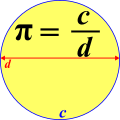Elementary algebra
Elementary algebra is the most basic form of algebra taught to students. It is often one of the next areas of mathematics taught to students after arithmetic. While in arithmetic only numbers and operators like +, −, ×, and ÷ occur; in algebra, variables (like a, x, y) are used to stand for numbers. This is useful because:
- It lets people solve problems about "unknown" numbers. This means learning about equations and how to solve them (for example, "find a number x where [math]\displaystyle{ 3x + 1 = 10 }[/math]").
- It allows the generalization of the rules from arithmetic. While some students understand that [math]\displaystyle{ 3+4 = 4+3 }[/math], it helps to prove that [math]\displaystyle{ a + b = b + a }[/math] for all a and b. This makes algebra a good step to learning about abstraction (learning general ideas from many examples).
- It helps people understand and create functional relationships (also sometimes called cause and effect). An example of this is "if x tickets are sold, then the profit will be [math]\displaystyle{ 3x - 10 }[/math] dollars".
These three are the main strands of elementary algebra. Elementary algebra is often used in many other subjects, like science, business, and building. Abstract algebra, a much more advanced topic, is generally taught late in college.
Simple algebra problems
If an equation has only one number that is unknown it is sometimes easy to solve. The unknown number is called "x":
- [math]\displaystyle{ 2x + 4 = 12. \, }[/math]
To solve a simple equation with one unknown amount add, subtract, multiply, or divide both sides of the equation by the same number in order to put the unknown amount, x, on one side of the equation. Once x is by itself on one side, use arithmetic to determine the amount on the other side of the equation.[1] For example, by subtracting 4 from both sides in the equation above:
- [math]\displaystyle{ 2x + 4 - 4 = 12 - 4 \, }[/math]
getting:
- [math]\displaystyle{ 2x = 8 \, }[/math]
Dividing both sides by 2:
- [math]\displaystyle{ \frac{2x}{2} = \frac{8}{2} \, }[/math]
getting:
- [math]\displaystyle{ x = 4. \, }[/math]
It may help to think of this equation as a see-saw or balance, what you do to one side, you must do to the other and your main aim is to get x by itself.
Definitions
[math]\displaystyle{ 3x^2 - 2xy + c }[/math] has the following components:

1 – power (exponent)
2 – coefficient
3 – term
4 – operator
5 – constant term
[math]\displaystyle{ c }[/math] – constant
[math]\displaystyle{ x }[/math] [math]\displaystyle{ y }[/math] – variables
Elementary Algebra Media
Example of variables showing the relationship between a circle's diameter and its circumference. For any circle, its circumference c, divided by its diameter d, is equal to the constant pi, \pi (approximately 3.14).
Animation illustrating Pythagoras' rule for a right-angle triangle, which shows the algebraic relationship between the triangle's hypotenuse, and the other two sides.
Notes
- ↑ Slavin, Steve (1989). All the Math You'll Ever Need. John Wiley & Sons. p. 72. ISBN 0471506362.







